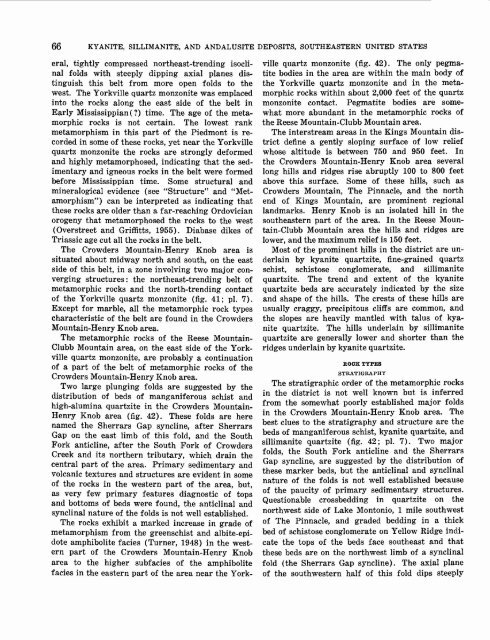Kyanite, Sillimanite, and Andalusite Deposits of the Southeastern ...
Kyanite, Sillimanite, and Andalusite Deposits of the Southeastern ...
Kyanite, Sillimanite, and Andalusite Deposits of the Southeastern ...
You also want an ePaper? Increase the reach of your titles
YUMPU automatically turns print PDFs into web optimized ePapers that Google loves.
66 KYANITE, SILLIMANITE, AND ANDALUSITE DEPOSITS, SOUTHEASTERN UNITED STATES<br />
eral, tightly compressed nor<strong>the</strong>ast-trending isoclinal<br />
folds with steeply dipping axial planes distinguish<br />
this belt from more open folds to <strong>the</strong><br />
west. The Yorkville quartz monzonite was emplaced<br />
into <strong>the</strong> rocks along <strong>the</strong> east side <strong>of</strong> <strong>the</strong> belt in<br />
Early Mississippian(?) time. The age <strong>of</strong> <strong>the</strong> metamorphic<br />
rocks is not certain. The lowest rank<br />
metamorphism in this part <strong>of</strong> <strong>the</strong> Piedmont is recorded<br />
in some <strong>of</strong> <strong>the</strong>se rocks, yet near <strong>the</strong> Yorkville<br />
quartz monzonite <strong>the</strong> rocks are strongly deformed<br />
<strong>and</strong> highly metamorphosed, indicating that <strong>the</strong> sedimentary<br />
<strong>and</strong> igneous rocks in <strong>the</strong> belt were formed<br />
before Mississippian time. Some structural <strong>and</strong><br />
mineralogical evidence (see "Structure" <strong>and</strong> "Metamorphism")<br />
can be interpreted as indicating that<br />
<strong>the</strong>se rocks are older than a far-reaching Ordovician<br />
orogeny that metamorphosed <strong>the</strong> rocks to <strong>the</strong> west<br />
(Overstreet <strong>and</strong> Griffitts, 1955). Diabase dikes <strong>of</strong><br />
Triassic age cut all <strong>the</strong> rocks in <strong>the</strong> belt.<br />
The Crowders Mountain-Henry Knob area is<br />
situated about midway north <strong>and</strong> south, on <strong>the</strong> east<br />
side <strong>of</strong> this belt, in a zone involving two major converging<br />
structures: <strong>the</strong> nor<strong>the</strong>ast-trending belt <strong>of</strong><br />
metamorphic rocks <strong>and</strong> <strong>the</strong> north-trending contact<br />
<strong>of</strong> <strong>the</strong> Yorkville quartz monzonite (fig. 41; pi. 7).<br />
Except for marble, all <strong>the</strong> metamorphic rock types<br />
characteristic <strong>of</strong> <strong>the</strong> belt are found in <strong>the</strong> Crowders<br />
Mountain-Henry Knob area.<br />
The metamorphic rocks <strong>of</strong> <strong>the</strong> Reese Mountain-<br />
Clubb Mountain area, on <strong>the</strong> east side <strong>of</strong> <strong>the</strong> Yorkville<br />
quartz monzonite, are probably a continuation<br />
<strong>of</strong> a part <strong>of</strong> <strong>the</strong> belt <strong>of</strong> metamorphic rocks <strong>of</strong> <strong>the</strong><br />
Crowders Mountain-Henry Knob area.<br />
Two large plunging folds are suggested by <strong>the</strong><br />
distribution <strong>of</strong> beds <strong>of</strong> manganiferous schist <strong>and</strong><br />
high-alumina quartzite in <strong>the</strong> Crowders Mountain-<br />
Henry Knob area (fig. 42). These folds are here<br />
named <strong>the</strong> Sherrars Gap syncline, after Sherrars<br />
Gap on <strong>the</strong> east limb <strong>of</strong> this fold, <strong>and</strong> <strong>the</strong> South<br />
Fork anticline, after <strong>the</strong> South Fork <strong>of</strong> Crowders<br />
Creek <strong>and</strong> its nor<strong>the</strong>rn tributary, which drain <strong>the</strong><br />
central part <strong>of</strong> <strong>the</strong> area. Primary sedimentary <strong>and</strong><br />
volcanic textures <strong>and</strong> structures are evident in some<br />
<strong>of</strong> <strong>the</strong> rocks in <strong>the</strong> western part <strong>of</strong> <strong>the</strong> area, but,<br />
as very few primary features diagnostic <strong>of</strong> tops<br />
<strong>and</strong> bottoms <strong>of</strong> beds were found, <strong>the</strong> anticlinal <strong>and</strong><br />
synclinal nature <strong>of</strong> <strong>the</strong> folds is not well established.<br />
The rocks exhibit a marked increase in grade <strong>of</strong><br />
metamorphism from <strong>the</strong> greenschist <strong>and</strong> albite-epidote<br />
amphibolite facies (Turner, 1948) in <strong>the</strong> western<br />
part <strong>of</strong> <strong>the</strong> Crowders Mountain-Henry Knob<br />
area to <strong>the</strong> higher subfacies <strong>of</strong> <strong>the</strong> amphibolite<br />
facies in <strong>the</strong> eastern part <strong>of</strong> <strong>the</strong> area near <strong>the</strong> Yorkville<br />
quartz monzonite (fig. 42). The only pegmatite<br />
bodies in <strong>the</strong> area are within <strong>the</strong> main body <strong>of</strong><br />
<strong>the</strong> Yorkville quartz monzonite <strong>and</strong> in <strong>the</strong> metamorphic<br />
rocks within about 2,000 feet <strong>of</strong> <strong>the</strong> quartz<br />
monzonite contact. Pegmatite bodies are somewhat<br />
more abundant in <strong>the</strong> metamorphic rocks <strong>of</strong><br />
<strong>the</strong> Reese Mountain-Clubb Mountain area.<br />
The interstream areas in <strong>the</strong> Kings Mountain district<br />
define a gently sloping surface <strong>of</strong> low relief<br />
whose altitude is between 750 <strong>and</strong> 950 feet. In<br />
<strong>the</strong> Crowders Mountain-Henry Knob area several<br />
long hills <strong>and</strong> ridges rise abruptly 100 to 800 feet<br />
above this surface. Some <strong>of</strong> <strong>the</strong>se hills, such as<br />
Crowders Mountain, The Pinnacle, <strong>and</strong> <strong>the</strong> north<br />
end <strong>of</strong> Kings Mountain, are prominent regional<br />
l<strong>and</strong>marks. Henry Knob is an isolated hill in <strong>the</strong><br />
sou<strong>the</strong>astern part <strong>of</strong> <strong>the</strong> area. In <strong>the</strong> Reese Mountain-Clubb<br />
Mountain area <strong>the</strong> hills <strong>and</strong> ridges are<br />
lower, <strong>and</strong> <strong>the</strong> maximum relief is 150 feet.<br />
Most <strong>of</strong> <strong>the</strong> prominent hills in <strong>the</strong> district are underlain<br />
by kyanite quartzite, fine-grained quartz<br />
schist, schistose conglomerate, <strong>and</strong> sillimanite<br />
quartzite. The trend <strong>and</strong> extent <strong>of</strong> <strong>the</strong> kyanite<br />
quartzite beds are accurately indicated by <strong>the</strong> size<br />
<strong>and</strong> shape <strong>of</strong> <strong>the</strong> hills. The crests <strong>of</strong> <strong>the</strong>se hills are<br />
usually craggy, precipitous cliffs are common, <strong>and</strong><br />
<strong>the</strong> slopes are heavily mantled with talus <strong>of</strong> kyanite<br />
quartzite. The hills underlain by sillimanite<br />
quartzite are generally lower <strong>and</strong> shorter than <strong>the</strong><br />
ridges underlain by kyanite quartzite.<br />
ROCK TYPES<br />
STRATIGRAPHY<br />
The stratigraphic order <strong>of</strong> <strong>the</strong> metamorphic rocks<br />
in <strong>the</strong> district is not well known but is inferred<br />
from <strong>the</strong> somewhat poorly established major folds<br />
in <strong>the</strong> Crowders Mountain-Henry Knob area. The<br />
best clues to <strong>the</strong> stratigraphy <strong>and</strong> structure are <strong>the</strong><br />
beds <strong>of</strong> manganiferous schist, kyanite quartzite, <strong>and</strong><br />
sillimanite quartzite (fig. 42; pi. 7). Two major<br />
folds, <strong>the</strong> South Fork anticline <strong>and</strong> <strong>the</strong> Sherrars<br />
Gap syncline, are suggested by <strong>the</strong> distribution <strong>of</strong><br />
<strong>the</strong>se marker beds, but <strong>the</strong> anticlinal <strong>and</strong> synclinal<br />
nature <strong>of</strong> <strong>the</strong> folds is not well established because<br />
<strong>of</strong> <strong>the</strong> paucity <strong>of</strong> primary sedimentary structures.<br />
Questionable crossbedding in quartzite on <strong>the</strong><br />
northwest side <strong>of</strong> Lake Montonio, 1 mile southwest<br />
<strong>of</strong> The Pinnacle, <strong>and</strong> graded bedding in a thick<br />
bed <strong>of</strong> schistose conglomerate on Yellow Ridge indicate<br />
<strong>the</strong> tops <strong>of</strong> <strong>the</strong> beds face sou<strong>the</strong>ast <strong>and</strong> that<br />
<strong>the</strong>se beds are on <strong>the</strong> northwest limb <strong>of</strong> a synclinal<br />
fold (<strong>the</strong> Sherrars Gap syncline). The axial plane<br />
<strong>of</strong> <strong>the</strong> southwestern half <strong>of</strong> this fold dips steeply
















